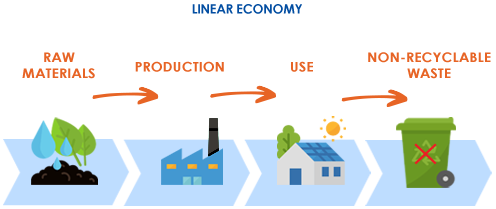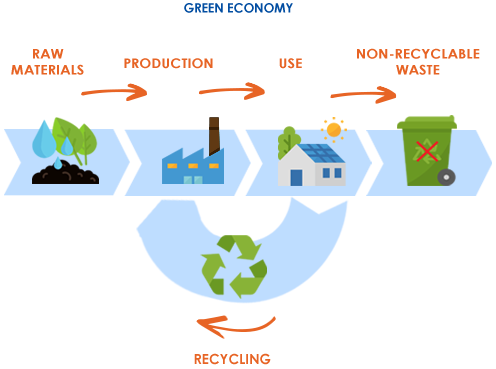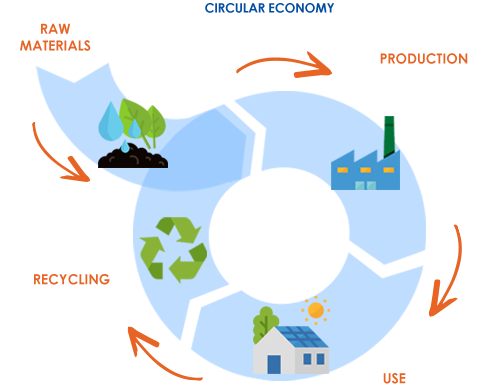• is radically different from the prevailing linear economy,
• is inspired by the natural world's rules of perpetual recycling and recovering of materials,
• and thus designed on the basis of principles such as reuse, recycle, redesign, remanufacture, reduce and recover throughout the entire system from production to consumption and at every level from particular products and services to the macro economy,
• and with the aim to accomplish sustainable economic, social and environmental development to the benefit of current and future generations.

is the dominant model in today’s market economies. Production, distribution and consumption are organized as a sequence of activities along unidirectional supply chains with a start (provision of resources) and an end (disposal of waste). In such ‘take-make-use-dispose’ regime, value-creation mainly results from (extensive or intensive) exploitation of natural and human resources. Due to the regulative framework that sustains the linear economy, economic agents do not have to consider the costs of their negative impact on the environment and in most cases have no restrictions in their access to virgin natural resources besides the limits given by their financial power.

is a transitional economic model between the linear and the circular economy models. In the model, resource-effective and environment-friendly technologies are applied at individual links in the supply chains, allowing for exploitation of circular principles such as recycling, remanufacturing, composting and energy recovery. The system still creates “waste” of natural and human resources which are disposed of without being restored and brought back into economic circuits (or human use).

defines a set of principles for production and consumption, radically different from the linear ‘take-make-dispose’ regime and goes further than calling for implementation of ‘green’ solutions. It requires a broader and more comprehensive design of radically alternative solutions over the entire life cycle of products and adoption of closing-the loop production and consumption patterns within the entire economic system. The CE relies on value creation through restoration, regeneration, and re-use of resources as well as continuous cascades of related resource flows. The CE is enabled by new types of business models and technologies, new forms of consumption discarding ownership and relying on active ‘users’ rather than passive ‘consumers’, as well as by new types of public infrastructures, legislation and policies encouraging reduction of the use of resources.
• Regenerative design: Processes within all systems must renew or regenerate the sources of energy and materials that they consume, in order to stay within the limits of nature.
• Performance Economy: A vision of an economy in loops. This includes the principles of product-life extension, long-life goods, reconditioning activities, and waste prevention. Selling services instead of goods is a cornerstone, proposing payment for the performance that products deliver rather than its materiality.
• Cradle to cradle: A vision of material flows as loops. Technical elements should not have components that harm the environment, while biological components should be biodegradable. The materials flow through an entire cycle from production over use to re-use or disassembly, and refurbishment should be considered from the design phase.
• Industrial Ecology: Production processes are designed, organized and localized so that they function in ways that allow for synergies, and thereby mimicking the living systems.
• Biomimicry: Inspired by nature, this approach tries to imitate nature’s designs and processes to find solutions to problems encountered by human socjety in various areas of its activity.
• Blue Economy: Blue economy gains knowledge from the way in which organisms are formed. It stresses that when seeking solutions to the problems faced by socjety, the local environment, physical and environmental conditions appropriate to the issue in question must be taken into account.
see CE Handbook chapters: 1, 2
Today’s linear market economy includes some circular aspects such as recycling, maintenance, composting etc., and also is geared to optimize and economize the use of (any) production resources. But even if that economy attempts to protect environment and increase economic effectiveness, it is unable to minimize waste and use of natural resources. Circular economy has the potential to offer systemic transformation and transform production, services and consumption within entire value chains and across different value chains with better effects in the economy and environment. In the table below, we distinguish between two phases in the implementation of the circular economy. CE 1.0 includes circular elements and innovations that are applicable at the firm level and in the immediate future. The CE 2.0 aims at systemic transition and expresses a shift toward a new socio- and techno- economic paradigm.
| linear economy | green economy/ sustainable | circular economy 1.0 | circular economy 2.0 | |
|---|---|---|---|---|
| Motto | Take-make-use-dispose | Cradle-to-grave | Cradle-to-cradle | Spaceship earth |
| Economic value creation | Growth through extensive or intensive use of resources | Investments and innovations in sustainable tech-nologies | Innovation of circular resource de-sign at niche level | Competitive/Right positioning in an emerging circular resource regime |
| Production of tourism services | Increase number of tourists or the profit per guest | Strive to make business activities (environmentally, socially and economically) sustainable | Perceive all re-source flows through tourism as opportunity for creating profitable circularised flows and value chains | Systemic transition and adaptation to a circular resource regime |
| Consumption of tourism services | Hedonistic, luxury experiences | Luxury ‘back-pack’ experiences of sustainable places and communities. | Hotels and tourism services are ‘living CE labs’ for explor-ing relations between cul-ture/daily life and environment | To be seen |
| Energy technologies | Fossils-based. Continuous im-provement of technological capacity and efficiency. | Shift to sustaina-ble, non-carbon-based energy sources. Optimise energy use and minimise consumption. | Shift to sustainable, non-carbon-based energy sources. Optimise energy use and minimise consumption. | Transition of all en-ergy systems through regenera-tion into perpetu-ally circular energy sources. |
| Waste | Dispose as quickly and cheaply as possible | Create as little waste as possible and dispose it as environmentally friendly as possible | Waste is a ‘re-source out of place’ | Use systems of all natural resources are designed to be circular (perpetually reusable). |
| Water | Extract-use-clean-dispose in streams and oceans and let eco-system re-generate ‘naturally’ | Extract-use-clean as much as possible through water treatment plants. Dispose of rest in streams and oceans and let eco-system regenerate ‘naturally’ | In-house grey-water systems | Circular water sys-tems installed in all regions, designed with separate black, grey and portable water systems. |
| Dominant business models | Production/supply of goods and services | Development and delivery of high-tech green solutions and advice | Maintenance, repair and design for durability in current technology products | Integration of cir-cular technologies and flows of material and immaterial resources |
The CE concept is based on a number of organizing principles presenting key activities. There are several attempts of formulating such principles in the literature. Below we present the most popular:
![]() 3R principle: Reduction, Reuse and Recycle.
3R principle: Reduction, Reuse and Recycle.
• The Reduction principle aims to minimize the input of primary energy, raw materials and waste through the improvement of efficiency in production consumption processes.
• The Reuse principle – to repeatedly re-use products or components for the same purpose for which they are designed.
• The Recycle principle refers to an operation by which waste materials are reprocessed into products, materials or substances whether for the original or other purposes.
![]() 6Rs principles, formulated as Reuse, Recycle, Redesign, Remanufacture, Reduce, and Recover
6Rs principles, formulated as Reuse, Recycle, Redesign, Remanufacture, Reduce, and Recover
![]() ReSOLVE - An alternative CE business action framework
ReSOLVE - An alternative CE business action framework
A ”business action framework” has been developed by the Ellen MacArthur Foundation, based on three fundamental 3R principles. It involves six guiding actions.
Shift to renewable energy and materials; reclaim, retain, and regenerate health of ecosystems; and return recovered biological resources to the biosphere.
Share assets (e.g. cars, rooms, appliances); reuse or use second-hand; prolong life through maintenance, design for durability, upgradability, etc.
Increase performance/efficiency of products; remove waste in production and supply chains; leverage big data, automation, remote sensing and steering.
Close value chains via remanufacturing of products or components; recycle materials; digest anaerobically; extract biochemicals from organic waste.
Transform activities, services and offered products into digital processes and information: books, music, travel, online shopping, autonomous vehicles, etc.
Replace old non-renewable with advanced renewable materials; apply new technologies (e.g. 3D printing); choose products/services based on renewable resources (e.g. multimodal transport).
A central aspect of a transition toward a circular economy is the innovation of circular business models. A business model is a tool used in order to depict how an organisation creates, delivers and captures value. In order to obtain a circular business model, a business does not need to close all its resource loops within the firm. A circular business model can also be one in which the company operates as part of a larger system and adds to other companies’ circular business models, which together create a closed loop system.
![]() Waste as a resource business model
Waste as a resource business model
Business models that aim to use waste as a resource can promote cross-sector and cross-cycle links by creating links for secondary raw materials.
Waste management business models relevant for tourism SMEs
Within the three tourism-based fields – hotel accommodation, hotel restaurants and spas – it is perceivable that businesses can potentially adopt waste management business models as part of their product line. Hotels may sell used textiles and linens, hotel restaurants may sell food waste, grease from their drainage sludge and other kitchen-based resources, while spas may sell greywaters with specific qualities as well as chemicals.
![]() Eco-design
Eco-design
Eco-design business models are based on products that are made with fewer natural resources, use recycled and renewable resources and/or use components that last longer and are easier to maintain, repair, upgrade and recycle. We can distinguish between two overall types of eco-design business models:
• product redesign by way of incremental improvements to existing products and business models
• new product design based on the development of new resource-efficient products that can be repaired, upgraded and recycled.
Eco-design business models relevant for tourism SMEs
Eco-design as a business model can be applied in all furniture and energy-related products and devices. Eco-design in refurbishing of hotels and in new constructions is treated in more detail when we analyse CE potentials in accommodation services.
![]() Other examples of circular business model
Other examples of circular business model
• Leasing: products from current high-value examples such as (industrial) equipment to cars and clothes. The tourism industry already provides such kind of leasing services for tourists, who leave everything but what can fit into a suitcase/car and rely on what is provided at their place of accommodation or destination.
• Reuse: A most obvious but also most neglected strategy. It may encompass re-use centres for diverse sorts of equipment and facility management companies.
• Remanufacturing: This involves restoring a product to a like-new or better status. It is especially relevant for companies that produce complex, higher value products and thus not so much for SMEs further down the value chain.
The CE is as much a transition that takes place at consumption side, as well as in the interaction between producers and consumers. The promotion of consumers’ co-responsibility is therefore crucial for enhancing the purchase and use of more sustainable products and services. Compared to most other industrial sectors, tourism plays a key role for encouraging more sustainable consumption patterns due to the close inter-personal host/guest relationship that is an integral element of tourism.
The proliferation of social sharing and consumer platforms in recent years is a testament to consumers’ willingness and demand to engage in responsible consumer behaviour – and the need to do so as part of an engaged community. Tourists as well as tourism businesses increasingly engage in practices of collaborative consumption, which are based on sharing, swapping, bartering, trading or leasing products and other assets such as land or even time. This is often organised around consumer-to-consumer direct contacts based on online sharing market places. Within tourism, this can be borrowing of local campers and caravans, tents, hairdryers, canoes, bicycles, decreasing the amount of ‘stuff’ that tourists must transport from one destination to another. Such forms of collaborative consumption are based on trust and on increasing social interaction within neighbourhoods. Possible environmental benefits include a decrease in the use of natural resources, energy and emissions in both production and consumption based on longer as well as more intensive use of existing products. However, there are also challenges. Longer and more intensive use of products does not guarantee any positive environmental impacts if these are inefficient. Social effects can also be both positive and negative. Possible positive effects include job creation and social interaction and cohesion between tourists and locals, while there also may be different barriers making people hesitant to lend possessions to temporary visitors, including insurance issues. As the ownership is at the core of our present consumption model, the loss of ownership is one of the strongest potential barriers that could limit the development of collaborative consumption. However, collaborative consumption models are recognized as one of the best available options for consumers to shift to CE from our current linear economy models. Consumers’ engagement expectedly will be enhanced through easy access to knowledge about product qualities and the circular resource flows that are embedded in products and services.
see CE Handbook section: 2.5
The traveling activity of tourists is often considerable and connected to high CO2 emissions and pollution as destinations often are distant from tourists’ residence and traveling therefore often is done by airplane or car. When tourists arrive at the destination, in most cases they already have made a considerable CO2 footprint, which will not disappear no matter how small the negative effects on the environment inflicted by their activities during their stay. Hence, at the very outset, the traveling component of tourism consumption and production challenges the environmental sustainability of tourism. The affluent consumption of food, water, energy and other resources that often characterise out-of-home holiday stays, further increases the environmental challenges of tourism and adds to its overall bad reputation regarding environmental (and social) sustainability. Nonetheless, tourism indeed has potential for encouraging a transition to a circular, more sustainable economy – on the production as well as consumption side.
Tourism businesses can reduce their use of resources and save costs by implementing circular principles (reduce, reuse, recycle, recover) in their operation and supply chains. For example:
As a direct consequence of the definition of tourism as the temporary staying of a person in a geographical place different from his home, tourism is defined as attendance-based consumption of services and experiences.
Tourism relies on an interpersonal host/guest relationship, which gives opportunities for deep, value-based interaction and for influencing the way guests think and behave not just during but also after their holiday. Tourism has the capacity to experiment with and reconfigure the way daily life is organized.
The Circular Economy can become a central part of the guest-host relationship and can be a way to include and engage guests in ways that add to their experience by allowing them to contribute and at the same time make sense from an environmental perspective.
Thus, hotels, restaurants, conference venues, and entire destinations could re-organize themselves as “Transformative Living Labs” where guests experience, play with, gain information and knowledge about and radically re-think the organization of their daily life and their use of resources. Creating and operating such Transformative Living Labs may lead to important processes of revaluation and acceptance of new circular/sustainable technologies and cultural values. Such cultural revaluation processes are crucial for changing the requirements of tourists with regard to travel conditions in more sustainable directions.
see CE Handbook section: 4